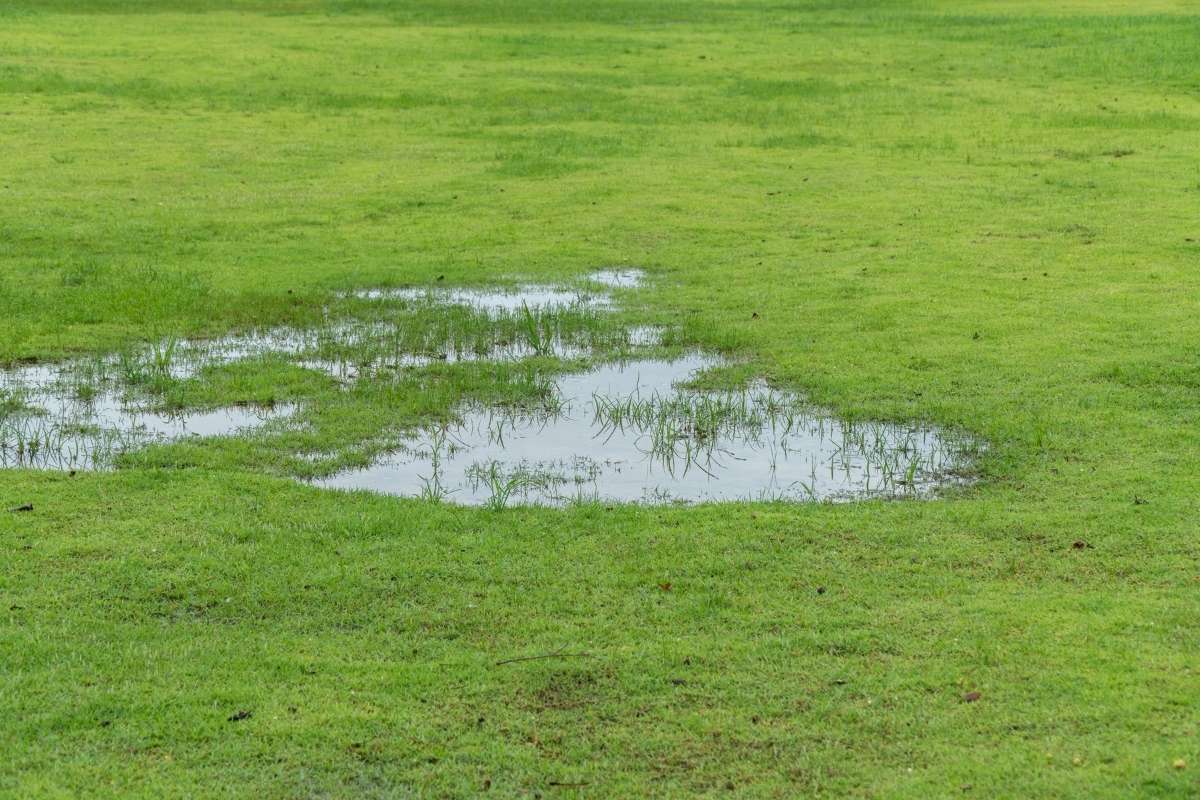
No home looks good with standing water or puddles that refuse to drain. If left untouched, they can cause problems to your landscape, turfgrass, foundation, and even your health.
Learning how to get rid of standing water can help you eliminate the eyesore and prevent the issues that stagnant water brings. Here are 12 effective methods you can tackle, including installing a French drain, dethatching, aeration, and improving surface drainage and soil structure.
- 1. Improve Surface Drainage
- 2. Install a French Drain
- 3. Water Wisely
- 4. Dethatch
- 5. Core Aerate
- 6. Improve Soil Structure
- 7. Create a Rain Garden
- 8. Fix Gutter and Downspout Issues
- 9. Install a Dry Well
- 10. Level Your Yard
- 11. Install a Sump Pump
- 12. Use Permeable Hardscaping
- FAQ About Getting Rid of Standing Water
1. Improve Surface Drainage
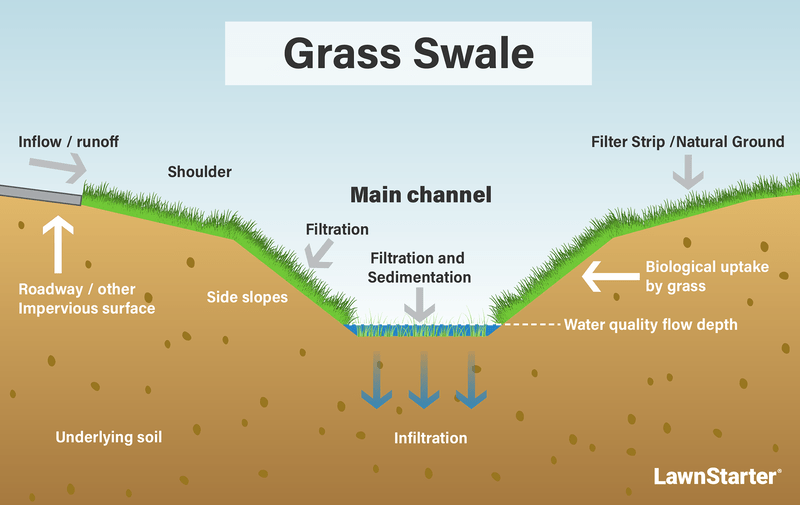
Several contributing factors can cause standing water in your yard. Stephen Robertson, extension field specialist at South Dakota State University, says heavy rainfall is the main culprit of stagnant water, while busted water pipes can be unpredictable.
There are several ways to improve drainage in your yard, and creating a swale is one good option. Usually lined with gravel or grass, a swale is a shallow ditch designed to direct water flow, control its speed, and assist with soil infiltration. It can help you redirect water to another place, like a rain garden or other holding area.
Estimated Cost: Depending on the project complexity, creating a swale costs around $0.50 per square foot. For proper installation, it’s better to hire a landscaping pro than tackle the project yourself.
2. Install a French Drain
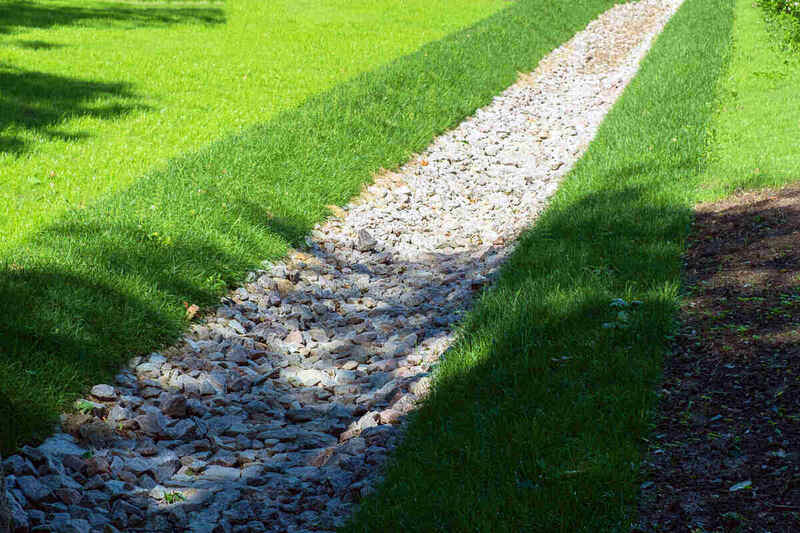
If you have soggy spots or water pooling around your home’s foundation, you can install a French drain to help move excess water away from your home. It’s a gravel-filled trench with a perforated pipe at the bottom.
Estimated Cost: Professional installation of a French drain costs $1,650 to $12,250, depending on factors like property size and drain location. If you have the skills to create the drain yourself, DIY costs usually fall around $700.
3. Water Wisely

According to Robertson, if the stagnant water issue stems from overwatering or improper irrigation setup, it’s within every homeowner’s control. Most of the time, it can be fixed by simply adjusting your watering habits.
He adds, “Know your soil type (soil types do not retain or drain water in the same way), grass type, and any ornamentals you may have, and adjust your watering to match your needs.”
Generally, you’ll need to water your lawn 2 to 3 times per week, with about 1 inch of water total. Watering less frequently but more deeply not only helps you avoid standing water issues but also encourages the root system to grow deeper.
Estimated Cost: Of course, you’ll have to pay your monthly water bill if you have city or municipal water. But if you have a well, this solution costs nothing. For stress-free watering, you can automate the process with a sprinkler. Professional installation of an above-ground sprinkler system costs around $0.29 to $0.48 per square foot.
4. Dethatch

Thatch is a layer of living and dead grass and roots that sit on top of the soil. If allowed to accumulate, it can become too thick, preventing water from draining into the soil. Lawn dethatching removes this barrier so moisture can pass through instead of sitting on the surface of the thatch.
Estimated Cost: To dethatch your lawn, you’ll need a thatch rake that costs around $30 or an electric dethatcher that sells for more than $100. On the other hand, professional dethatching costs around $0.04 to $0.06 per square foot.
Expert Tip: Thatch can be beneficial to your lawn as long as it doesn’t exceed a certain thickness. For warm-season grass, thatch should not exceed 1/2 inch. For cool-season grass, don’t let thatch accumulate past 1/3 inch.
5. Core Aerate

Robertson says, “Make sure turf is adequately aerated — turf that has roots that are too dense will not drain well.”
So, if you have compacted soil, you’ll want to fix the issue ASAP. Otherwise, it can cause water to pool and remain stagnant. Your best solution for soil compaction is to aerate your lawn. Aeration involves pulling out small plugs of soil from your lawn to reduce compaction and improve water absorption.
Estimated Cost: On average, lawn aeration costs around $144, but it can go as high as $636, depending on lawn size.
6. Improve Soil Structure
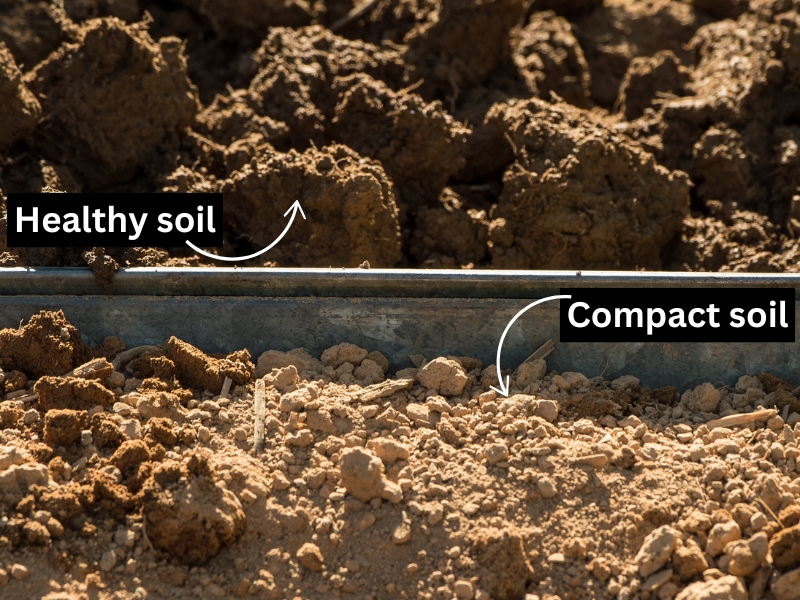
If you have compacted or heavy clay soil (over 50% of your soil consists of clay particles), it will cause pooling since water won’t be able to penetrate. To improve your soil structure, you can mix organic matter like aged manure, compost, or leaf mold into your soil.
Apart from creating air pockets for the water to flow through, adding organic matter will also add nutrients to the soil as it decomposes. Plus, if you use compost in your yard, it can significantly boost soil and plant health. Another way to improve your existing soil is by adding topsoil, which already contains organic matter, minerals, and nutrients.
Estimated Cost: Topsoil costs around $10 to $50 per cubic yard or around $100 to $750 per truckload.
7. Create a Rain Garden
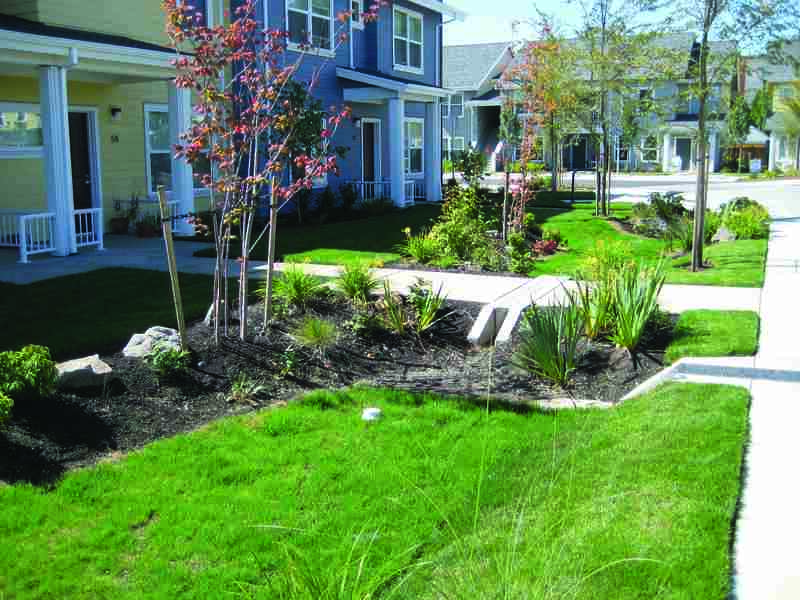
Heavy rainfall can cause water to collect in some areas of your yard, especially the low-lying parts. If you don’t want to create a swale to redirect the water, you can choose to build a rain garden to absorb the water instead. It can help reduce stormwater runoff while beautifying your landscape.
Estimated Cost: Expect to pay around $7.25 to $27 per square foot for professional installation of a rain garden.
8. Fix Gutter and Downspout Issues

If your gutters are clogged or your downspouts are dumping water right next to your house, you’re actually inviting standing water to form. To prevent this issue, don’t forget to clean your gutters twice a year (spring and fall) and have your downspouts extend at least 5 to 10 feet from your home’s foundation.
Estimated Cost: Unless you have the necessary tools and experience, it’s better to hire a pro to clean your gutters for around $105 to $375 or replace downspouts for around $4 per linear foot.
9. Install a Dry Well

Installing a dry well is another effective way to prevent or get rid of stagnant water in your yard. The dry well temporarily stores water and slowly filters it out into the surrounding soil.
Estimated Cost: The DIY cost for installing a dry well is usually between $185 to $385. If you hire a professional to do it for you, expect to pay $1,165 or more, depending on site conditions.
10. Level Your Yard

Low and uneven spots can act as a basin and collect water when it rains. According to Robertson, it’s important to “know the slope of your yard and identify low points to make amendments, improving drainage in those areas.”
Filling these spots and smoothing out your landscape can help water to flow and prevent pooling. If you have a shovel and topsoil mix, leveling your yard can be a DIY project you can do over the weekend. But if you can’t spare your weekend for this task, you can always hire a pro to help level your yard.
Estimated Cost: On average, leveling a yard costs $0.08 to $2.00 per square foot, so you can expect to pay anywhere from $310 to $6,910 for most jobs.
11. Install a Sump Pump

Typically installed in the basement or a pit in the yard, a sump pump can help collect standing water and pump it out to your chosen drainage area. It’s useful for homeowners living in flood-prone areas or those who have yards with high water tables.
Robertson agrees that installing a sump pump is the easiest solution to get rid of standing water in your yard. However, it involves complex setups and may include cutting into the concrete floor of your basement. So, it’s best to have the pros handle the installation.
Estimated Cost: Sump pump installation can cost as low as $452 or as high as $2,562, depending on the complexity of the excavation and electrical work.
See Related: Tips to Help Lawns Recover From Flood Damage
12. Use Permeable Hardscaping
Hardscaping with asphalt or concrete may seem practical. However, these materials are solid and may contribute to excessive runoff or pooling.
With permeable hardscaping, which uses permeable pavers, gravel, or porous concrete, water can seep into the ground, reducing surface water.
Estimated Cost: While it may be more expensive upfront, from $8.75 to $30.50 per square foot, you won’t have to worry about drainage issues down the road.
FAQ About Getting Rid of Standing Water
Besides being unsightly, standing water can hinder grass growth and create a favorable environment for weeds and pests like mosquitoes to thrive. The problem can also seep beyond your yard. If it’s near your basement or your home’s foundation, water can penetrate the soil and damage the underlying structure.
Yes, organic mulch like wood chips can absorb water (99% to 138% of their dry weight) by acting like a sponge, retaining water and preventing runoff. On the other hand, inorganic mulch like rubber or stone can help direct water away from problem spots in your lawn.
Yes, standing water poses health risks. It can attract pests like rodents and become a breeding ground for mosquitoes. It can also lead to mold and mildew in and around your home, which can cause allergies and other health issues.
Yes, some groundcover plants like daylilies, hostas, and rushes are great for absorbing water and facilitating water drainage. These plants can thrive in damp environments and have roots that absorb rainwater.
With the Right Pro, Standing Water Won’t Stand a Chance
Thanks to the sun’s heat, the stagnant water in your yard will eventually dry up (in a few weeks, maybe). But before it does, it may cause issues that will give you more than a headache.
With a little work, your yard can be puddle-free and ready for you to enjoy again — but you don’t have to do it yourself. Instead, hire a landscaping professional to resolve the standing water issue on your behalf so you can spend more quality time with your family and friends.
Sources:
- “Addressing Drainage Issues in the Urban Landscape.” By professors and extension specialists Daniel L. Thomas, Dennis Martin, Joshua Campbell, Hailin Zhang, Sergio Abit, Ali Mirchi, Sara Alian, and Saleh Taghvaeian. Oklahoma State University Extension.
- “Consider Using Permeable Surfaces When Hardscaping Your Yard.” By Amy Scaroni, PhD, assistant professor. Clemson University.
- Stephen Robertson, extension field specialist at South Dakota State University Extension. Personal interview.
- “Stormwater Management: Rain Garden Design for Homeowners.” By Thomas G. Franti, extension specialist, and Steven N. Rodie, extension specialist. University of Nebraska-Lincoln Extension.
- “Thatch Management in Lawns.” By Dennis L. Martin, professor and extension/research specialist. Oklahoma State University Extension.
- “Where Do Floodwaters Go and What Do They Leave Behind?” By Sushant Mehan, assistant professor and extension specialist. South Dakota State University.
- “Wood Chips and Applications of Wood Chips in Stormwater.” Minnesota Pollution Control Agency.
Main Image Credit: toa555 / Adobe Stock